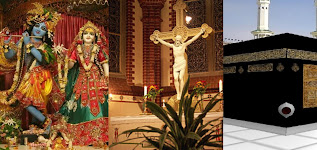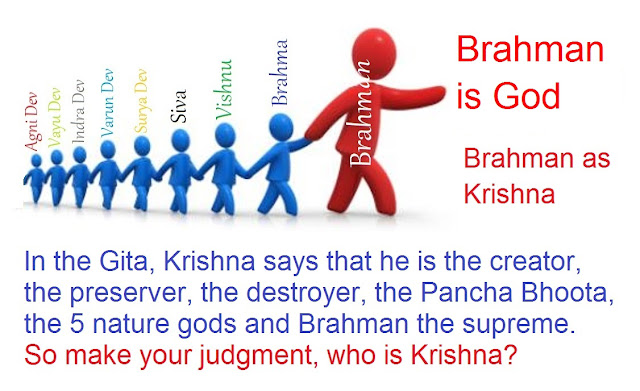Science in prayers
Growing up as a child I was trained with the values of Sanatan Vedic Hindu Dharma. My illiterate mother had always inspired me to light a Diya (lamp) in the morning and in the evenings. Looking at the prayer altar, I always looked at a few images of Hindu deities and the Diya burning. I was given a set of prayers that I was to recite.
This image
and procedural teachings of my mother remained in my mind and as my intellect
got stimulated with the real world, I started experiencing the ritualistic life
of the many Hindus. It was here my reasoning went beyond the normalcy of
ceremonial practice and observed a very similar mindset of others which I grew
up with.
Many of the non-Hindus made fun of Idol and fire worship and regarded their religions as the supreme. This is the first time that my stimulated intellect activated the hidden consciousness within me. Having visited many religious organizations I observed that each had an object that they either respected or preached. Hindus had idols of their respected deities; Christen had a wooden cross and in Islam, the sacred direction towards Mecca, or more precisely, towards the sacred Kaaba in Mecca. Muslims face this direction in prayer and during various other ritual acts (Note; The Kaaba was a sanctuary in pre-Islamic times. Muslims believe that Abraham—known as Ibrahim in the Islamic tradition—and his son, Ismail, constructed the Kaaba. ... Upon his return to Mecca in 629/30 CE, the shrine became the focal point for Muslim worship and pilgrimage. The Kaaba is built around a sacred black stone; a meteorite that Muslims believe was placed by Abraham and Ishmael in a corner of the Kaaba, a symbol of God's covenant with Abraham and Ishmael and, by extension, with the Muslim community itself. It is embedded in the eastern corner of the Kaaba.) which convinces me that the Muslims also have an object of worship.
From the three main religions of the world, I concluded that natural objects were taken and revered as an object of worship by reciting words or making sounds calling it prayers while concentrating on these objects, why?
My childhood
memories reminded me that in prayer or worship there should be an object one
must pray for; it must be visible and must be accommodated with sound? That
brings to me the prerequisite of a prayer ritual that must have matter,
light, and sound (vibration). Can I relate this to science? Yes
Light is composed of particles called photons, and matter is composed of particles called electrons, protons, neutrons. Yes, this reminded me of the double-slit experiment on the light in science where consciousness was named and debated. (One of the most famous experiments in physics is the double-slit experiment. It demonstrates, with unparalleled strangeness, that little particles of matter have something of a wave about them, and suggests that the very act of observing a particle has a dramatic effect on its behavior.) This is light and it is because of its existence that we can see.
Secondly the
chemistry of matter, Matter is made of particles (atoms and molecules) that are
too small to be seen with the unaided eye and molecules do not stop moving at
absolute zero in the matter. They move much less than at higher temperatures,
but they still have small vibrations at absolute zero. The matter is anything
that has mass and volume. Mass is the amount of matter in an object. The mass
of an object does not change. The word matter is sometimes used to refer to a
pure substance. Air surrounding you, means it occupies space. So air is an
example of matter even you are an excellent example of matter, you have mass
and occupy space. Likewise, water, sun, earth, moon, electron, proton, mesons,
quarks are also examples of matter.
Sound is the
term to describe what is heard when sound waves pass through a medium to the
ear. All sounds are made by vibrations of molecules through which the sound
travels or sound is produced when something vibrates. Sound travels through the
vibration of atoms and molecules in a medium (such as air or water). In space,
where there is no air, the sound has no way to travel.
The common factor of sound and matter is that they are the properties of vibrating molecules and light is described by waves and particles. This simple science allows me to describe why we communicate with the matter, sound, and light with our creator or so-called god. Note; there is no god but a devotee has created god and so he is in control of the so-called god. Accepting that everything vibrates at its own natural frequency, if you could discover the frequencies of any identified entities then one could destroy them with the same vibrational frequency or go into resonance. Resonance is the state of a system in which an abnormally large vibration is produced in response to an external stimulus, occurring when the frequency of the stimulus is the same, or nearly the same, as the natural vibration frequency of the system.
The theory of
resonance, in chemistry, is the theory by which the actual normal state of a
molecule is represented not by a single valence-bond structure but by a
combination of several alternative distinct structures. A devotee can bring any
object to this state with the 3 vibrations that it will produce.
With this argument, I am convinced that with the right sound one can change the frequency
of matter and finally bank or retrieve the required vibration one desires.
Hence prayer is a set of vibrations that can communicate with matter and by
gazing at that matter one stimulates consciousness. Here is where I am
convinced that the Hindu idols have resonating vibration that produces
abnormally large vibration which is shared for the benefit of its devotees. So
the worship of idols, reading Holy Scripture, reciting mantras, people going to
partake in 'darshan'(an opportunity to see or an occasion of seeing a holy
person or the image of a deity.) has a meaningful science through which people
communicated with their creator.
Sanatan Vedic
Hindu Dharma has played a meaningful role in stimulating the intellects of evolving humans from the beginning of time. It has considered all matter,
vibrations, and sight besides designed rituals to worship its creator.
The simplest act given to its devotees is a prayer ritual and to this day it is a continuation of the creation of great thinkers who had communicated with consciousness who had a stimulated consciousness. The five main Vedic deities who are mainly Nature gods and who have touched the cycle of life of man are Surya- Sun God, Indra- King of Gods, Agni- God of fire, Vayu- God of Winds, Varuna- God of water.
In addition, is matter described as the five tattvas, which we experience as qualities in the body and in all matter, are: Earth, Water, Fire, Air, and Ether (Panchmahaboot) or five great elements, also five a physical element is a group of five basic elements, which, according to Hinduism is the basis of all cosmic creation. Hence worshiping of matter in Hinduism is in harmony with its creation and the surrounding.
Having said
that all matter has vibrational energy in it one seeks to communicate with
these vibrations hoping to reach higher planes. Everything vibrates at its own
natural frequency and if you could discover the frequencies of any identified
entities then one could destroy them with the same vibrational frequency or
create resonance to experience the resultant vibration. This is what the intellectual
yogis do with their meditation.
To experience
the communication with the creator the Hindus created a prayer ritual that
included matter and used sound to create the required vibration. The vocal
sounds were enriched with the ringing of the bell, blowing of the conch, and
playing of musical instruments. In this process, the vibration of the
surrounding resonated AUM (OM). This is the vibration which was regarded as the finite vibration that can
reach the cosmic vibration and hence it is encouraged to repeat Om with the
beginning and end of any mantras, prayers, or recitation in the praise the
creator.
The science
of prayer has been long forgotten but the Hindus of today worship the five
Vedic Nature gods in a prayer ritual, invoking the Soul (Jivatman). The faith
and respect in the worship of these Vedic gods go as far back as 12 000 years.
• Hindus
always face the east to acknowledge the rising Sun.
• By making a
tiluck on the foreheads of idols or pictures of a family deity (Ishtadev)
Idradevs power is evoked.
• In lighting
the lamp (Deepak) one evokes Agnidev, the true spirit.
• We also
confirm the presence of Vayudev by lighting an agaratti, loban or camphor,
evoking his ability to take our day’s message to the Lord.
• By putting
a tiluk, swastika, or Aum on the container of water one evokes Varunadev. This
is to confirm the truth that Vedas worship. Truth is infinite and timeless
By doing these rituals, we evoke the supreme Soul (Paramatma) or the one God (Prabhu) who is ageless, formless, and sexless. With praises to God, repeating mantras, and approaching the end of the ritualistic worship we perform the aarti.
The aim of the prayer
ritual is to activate the intellect so that consciousness is stimulated. This
allows all dualities to be eliminated from information and facts then
singularity defines the required non-contradictory reasoning. Consciousness is
that truth that defines reality when truth activates the intellect to
accept consciousness as the supreme. In simple terms, one
experience the resonating vibrations from the creator which will create sustain
and destroy the entities which surround you. This is the ultimate realization
for mankind.
Note;
Here again, I am suggesting that a devotee must be an observer and if his devotion stimulates the consciousness
then he or she will create God
(Prabhu) with faith and devotion for whom god
will truly exist. In reality, God is a created image that does not exist
but consciousness gives it a form of energy. That is why I will call God my
creator and suggest that one must always activate its intelligence.
Or God does not exist but a devotee
with activated intelligence and a stimulated consciousness gives birth to god
and the existence of God becomes finite for that devotee.
Why I keep on mentioning an
activated intellect is because all organic life has a dormant intellect
programmed in its DNA. I would like to call god has Prabhu because the devotee
has created god in his image as a human being idealizing "Purushottama" meaning
"Supreme Purusha", "Supreme Being", "Supreme
God". It means "Foremost Amongst All Men"














